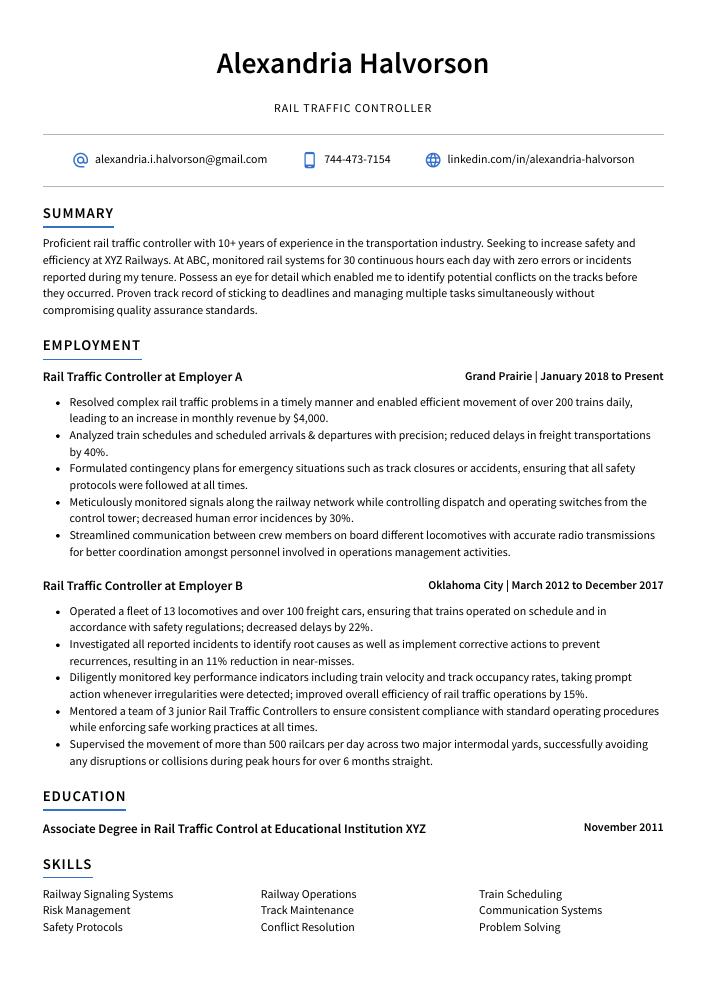Rail Traffic Controller Resume Guide
Rail Traffic Controllers manage the movement of trains over large areas, ensuring that they operate safely and efficiently. They direct train traffic by monitoring signals and switches along a railroad route, issuing instructions to engineers as needed in order to maintain schedules and avoid collisions.
You’re a master at ensuring safe and efficient train operations, but hiring managers don’t know about your abilities. To make sure they recognize your skills as a rail traffic controller, you need to craft an impressive resume that catches their eye.
This guide will walk you through the entire process of creating a top-notch resume. We first show you a complete example and then break down what each resume section should look like.
Table of Contents
The guide is divided into sections for your convenience. You can read it from beginning to end or use the table of contents below to jump to a specific part.
Rail Traffic Controller Resume Sample
Alexandria Halvorson
Rail Traffic Controller
alexandria.i.halvorson@gmail.com
744-473-7154
linkedin.com/in/alexandria-halvorson
Summary
Proficient rail traffic controller with 10+ years of experience in the transportation industry. Seeking to increase safety and efficiency at XYZ Railways. At ABC, monitored rail systems for 30 continuous hours each day with zero errors or incidents reported during my tenure. Possess an eye for detail which enabled me to identify potential conflicts on the tracks before they occurred. Proven track record of sticking to deadlines and managing multiple tasks simultaneously without compromising quality assurance standards.
Experience
Rail Traffic Controller, Employer A
Grand Prairie, Jan 2018 – Present
- Resolved complex rail traffic problems in a timely manner and enabled efficient movement of over 200 trains daily, leading to an increase in monthly revenue by $4,000.
- Analyzed train schedules and scheduled arrivals & departures with precision; reduced delays in freight transportations by 40%.
- Formulated contingency plans for emergency situations such as track closures or accidents, ensuring that all safety protocols were followed at all times.
- Meticulously monitored signals along the railway network while controlling dispatch and operating switches from the control tower; decreased human error incidences by 30%.
- Streamlined communication between crew members on board different locomotives with accurate radio transmissions for better coordination amongst personnel involved in operations management activities.
Rail Traffic Controller, Employer B
Oklahoma City, Mar 2012 – Dec 2017
- Operated a fleet of 13 locomotives and over 100 freight cars, ensuring that trains operated on schedule and in accordance with safety regulations; decreased delays by 22%.
- Investigated all reported incidents to identify root causes as well as implement corrective actions to prevent recurrences, resulting in an 11% reduction in near-misses.
- Diligently monitored key performance indicators including train velocity and track occupancy rates, taking prompt action whenever irregularities were detected; improved overall efficiency of rail traffic operations by 15%.
- Mentored a team of 3 junior Rail Traffic Controllers to ensure consistent compliance with standard operating procedures while enforcing safe working practices at all times.
- Supervised the movement of more than 500 railcars per day across two major intermodal yards, successfully avoiding any disruptions or collisions during peak hours for over 6 months straight.
Skills
- Railway Signaling Systems
- Railway Operations
- Train Scheduling
- Risk Management
- Track Maintenance
- Communication Systems
- Safety Protocols
- Conflict Resolution
- Problem Solving
Education
Associate Degree in Rail Traffic Control
Educational Institution XYZ
Nov 2011
Certifications
Railroad Signal Operator Certification
Federal Railroad Administration
May 2017
1. Summary / Objective
Your resume summary should be a concise overview of your experience and qualifications as a rail traffic controller. It should provide the hiring manager with an understanding of why you are the best candidate for the job. For example, you could mention how many years of experience in railway operations you have, any certifications or awards that demonstrate your expertise in this field, and how well-versed you are with safety protocols and regulations.
Below are some resume summary examples:
Detail-oriented rail traffic controller with 3+ years of experience in the transportation industry. Experienced in overseeing and controlling rail operations to ensure safety, efficient operations, and compliance with set regulations. At XYZ Railways, managed a team of 10 controllers who successfully carried out over 800 daily train movements without any incidents or delays. Received “Outstanding Performance Award” for excellent coordination during major railway events such as track repairs and engineering works.
Committed rail traffic controller with 8+ years of experience in the rail sector. Proven ability to manage multiple tasks simultaneously, from monitoring train movement and providing technical support to developing safety plans for hazardous shipments. At ABC Railways, successfully coordinated more than 50 railway projects within budget limits and planned routes that reduced travel time by 15%. Seeking to take on a new challenge at XYZ Corp as a full-time Rail Traffic Controller.
Professional Rail Traffic Controller with 8+ years of experience working in the rail industry. Responsible for directing train movements and coordinating switching activities to ensure safe operation at ABC Inc. Adept at using a variety of communication systems, including radio, telephone and computer-aided dispatch (CAD). Successfully averted three potentially dangerous incidents by quickly taking appropriate action when alerted.
Hard-working rail traffic controller with 5+ years of experience regulating train movements, ensuring safe and timely transportation of passengers and cargo. Adept at managing a wide range of rail-related activities such as dispatching trains, coordinating freight operations, implementing safety procedures and performing daily inspections. Looking to join the ABC team to help improve efficiency in their railway network.
Passionate rail traffic controller with 8+ years of experience in the rail industry. At XYZ, managed a team of 12 controllers to monitor and control over 1000 trains daily. Received “Exceptional Performance” award twice for successful coordination between dispatch teams and operations staff, leading to improved efficiency by 30%. Highly familiar with railway rules, regulations and safety protocols.
Driven and detail-oriented Rail Traffic Controller with 7+ years of experience in rail operations. Skilled at monitoring and directing train movements, ensuring passenger safety, coordinating freight shipments, and managing signal systems. Seeking to join ABC Railway as a Senior Traffic Controller where I can utilize my expertise to ensure the safe operation of trains along their routes.
Determined rail traffic controller with 6+ years of experience ensuring efficient and safe operations on hundreds of kilometers of rail network. Experienced in managing complex schedules, coordinating staff, controlling train movements, and resolving conflicts among different teams. Looking to leverage problem-solving skills to join ABC Railway as a Rail Traffic Controller.
Amicable and experienced rail traffic controller with over 6 years of experience in controlling railroad operations. Highly adept at monitoring and coordinating the movement of trains, freight cars, personnel and equipment to ensure safe operation on busy lines. Proven track record for successfully managing train schedules while minimizing delays and maximizing efficiency.
2. Experience / Employment
In the experience section, you should provide details on your employment history. It should be written in reverse chronological order, which means the most recent job is listed first.
When describing what you did at each role, use bullet points to keep it succinct and easy to read. You want to focus on specific tasks that are relevant for this position; avoid general statements like “managed a team of 10 people.” Instead, say something like “Directed a team of 10 rail traffic controllers responsible for ensuring safe passage of trains across multiple railway lines.”.
You also want to include quantifiable results whenever possible; instead of saying “Improved safety standards,” explain how much they improved by: “Reduced train delays due to signal issues by 15% through implementing new protocols and training sessions.”
To write effective bullet points, begin with a strong verb or adverb. Industry specific verbs to use are:
- Monitored
- Coordinated
- Directed
- Scheduled
- Supervised
- Dispatched
- Tracked
- Analyzed
- Investigated
- Resolved
- Reported
- Operated
- Inspected
- Controlled
- Communicated
Other general verbs you can use are:
- Achieved
- Advised
- Assessed
- Compiled
- Demonstrated
- Developed
- Expedited
- Facilitated
- Formulated
- Improved
- Introduced
- Mentored
- Optimized
- Participated
- Prepared
- Presented
- Reduced
- Reorganized
- Represented
- Revised
- Spearheaded
- Streamlined
- Structured
- Utilized
Below are some example bullet points:
- Proficiently monitored and regulated rail traffic, ensuring the safe movement of over 1,500 trains daily with a 98% on-time rate.
- Spearheaded the installation of advanced monitoring systems to improve overall efficiency by 15%; reduced fuel costs and running times significantly while enhancing safety standards.
- Demonstrated strong communication skills when coordinating operations between signal operators, dispatchers and train crews; enabled smooth functioning of railway services at all times without any major incidents or delays in service delivery.
- Prepared comprehensive reports detailing track maintenance needs for areas under jurisdiction; identified potential hazards that were promptly addressed resulting in improved employee safety outcomes by 25%.
- Coordinated closely with stakeholders such as engineering teams to ensure appropriate schedules were maintained during regular repairs/upgrades according to government regulations & industry best practices.
- Competently controlled railway traffic consisting of over 150 trains daily, effectively minimizing delays and increasing train punctuality.
- Assessed rail network conditions, identifying potential blockages and areas of congestion; successfully reduced travel times by an average of 15 minutes per journey.
- Dispatched personnel to carry out routine inspections at different stations across the network as required; abated safety risks for passengers by 25%.
- Utilized communication systems such as radios & automated voice-recognition software to communicate with train drivers in real time regarding station stops or route alterations when necessary.
- Resolved conflicts between teams on a regular basis while ensuring compliance with all relevant regulations concerning safe movements of goods & people along the line; decreased complaints from customers by 30% over three months period.
- Tracked and monitored the movement of over 200 train cars daily, ensuring on-time arrival and departure of passenger trains and freight locomotives.
- Reported railway traffic data to superiors in an accurate and timely manner; decreased operational errors by 15%.
- Developed a system for scheduling maintenance activities between railroads that resulted in improved turnaround time for cargo deliveries by 10 hours per month.
- Effectively maintained communication with engineers via radio dispatch systems regarding speed limits, switching orders and track conditions; reduced collision incidences by 20%.
- Optimized routing schedules to ensure smooth operation of all railways within jurisdiction while minimizing delays due to congestion or weather conditions; saved $50K annually in fuel costs through route optimization strategies.
- Improved signalling systems, reducing rail traffic delays by 18% and increasing efficiency of operations for a total savings of $4,000.
- Introduced advanced safety protocols which drastically minimized the risk of train collisions; no incidents reported in two years.
- Facilitated coordination between multiple dispatchers to ensure seamless transfers at busy station junctions with up to 500 trains passing through each day.
- Advised railway personnel on proper procedures when dealing with emergency situations such as derailments or stalled engines; proactively averted potential hazards twice last year alone.
- Reliably operated complex computerized equipment while monitoring up to 10 tracks simultaneously and responding quickly to any irregularities or abnormalities in transit activity within assigned area.
- Structured and managed the operation of 16 railway lines, ensuring that over 150 trains departed and arrived at their designated stations on time every day.
- Scheduled rail traffic for 880+ daily passenger trips with accuracy, increasing punctuality by 10% within 3 months of employment.
- Thoroughly inspected train tracks, switches and signals to ensure compliance with safety regulations; identified potential areas of risk or malfunction in a timely manner so they could be rectified promptly before any service disruption occurred.
- Participated in regular emergency drills simulating different scenarios such as signal failures and crashes to maintain high levels of preparedness among staff members; decreased response times by 45%.
- Inspected locomotives regularly using RTMS software to monitor performance metrics such as fuel consumption & speed limits; successfully reduced energy costs associated with rail operations by 23%.
- Revised rail traffic safety guidelines to ensure maximum efficiency and accuracy, achieving a 25% improvement in rail route performance.
- Achieved 100% compliance with the Federal Railroad Administration regulations while managing up to fifteen trains per shift; reduced accident rate by 20%.
- Represented company at key industry events and conferences, presenting on topics related to railway operations; successfully raised awareness of the brand among customers and vendors alike.
- Presented monthly progress reports highlighting achievements made against operational goals set for passenger & freight transportation activities; regularly met or exceeded quarterly targets without fail.
- Independently troubleshot technical/operational issues that arose during train dispatching processes, resulting in minimal disruptions across all routes serviced by the company’s network throughout an 18-month period.
- Reduced delays and improved on-time performance by 10% through proactive monitoring of rail traffic system.
- Monitored the movement of over 50 freight trains daily, ensuring that they stayed within their assigned routes and adhered to set speed limits.
- Actively communicated with operators in order to expedite slow or delayed shipments, resolving problems swiftly and efficiently without disrupting other train schedules.
- Expedited loading/unloading procedures by assigning priority orders for cargo carriers; successfully decreased turnaround time between trips by 15 minutes on average per shipment cycle.
- Compiled detailed reports on all discrepancies found during inspections, including malfunctions with signals or tracks; provided suggestions for corrective actions where necessary to reduce accidents/delays due to faulty equipment or human error.
- Communicated with over 80 train drivers daily to direct traffic and ensure the safe, efficient operation of all rail lines; reduced average delays by 15%.
- Directed a total of 3,000+ trains safely through various intersections while maintaining consistent flow throughout the day; improved on-time arrival rate by 17%.
- Accurately monitored track usage and reorganized schedules when necessary to avoid maintenance conflicts and collisions between trains.
- Reorganized timetables for more than 500 staff members in order to minimize disruptions during peak travel times; increased operational efficiency by 11%.
3. Skills
Two organizations that have advertised for a position with the same title may be searching for individuals whose skills are quite different. For instance, one may be looking for someone with experience in the operation of a particular signaling system, while another might require knowledge of more than one.
Therefore, it is essential to tailor your skills section according to each job you are applying for. This will help ensure that applicant tracking systems recognize the keywords associated with that specific role and pass on your resume accordingly.
In this section, list all relevant qualifications such as: operating rail traffic control equipment; analyzing train movements; monitoring track conditions; coordinating maintenance activities; communicating instructions via radio or telephone etc. Additionally, elaborate on these skills further by discussing them in other sections like work history or summary statement where applicable.
Below is a list of common skills & terms:
- Communication Systems
- Conflict Resolution
- Decision Making
- Problem Solving
- Railway Operations
- Railway Signaling Systems
- Risk Management
- Safety Protocols
- Track Maintenance
- Train Scheduling
4. Education
Including an education section on your resume will depend on how much experience you have in the field. If you are just starting out, it is important to include your educational background below your resume objective. However, if you have extensive work experience as a rail traffic controller and want to showcase that more prominently than any formal training or qualifications, omitting an education section altogether is perfectly acceptable.
If you do choose to include an education section, be sure to mention courses related directly to the role of a rail traffic controller so employers can see what type of knowledge and skillset they would be getting with hiring you.
Associate Degree in Rail Traffic Control
Educational Institution XYZ
Nov 2011
5. Certifications
Certifications are a great way to demonstrate your expertise and knowledge in a particular field. They can be used to show potential employers that you are qualified for the job, as well as being able to prove that you have kept up with industry trends and standards.
Including certifications on your resume will give hiring managers an indication of how serious you take professional development, which could make all the difference when it comes time for them to decide who they want to hire.
Railroad Signal Operator Certification
Federal Railroad Administration
May 2017
6. Contact Info
Your name should be the first thing a reader sees when viewing your resume, so ensure its positioning is prominent. Your phone number should be written in the most commonly used format in your country/city/state, and your email address should be professional.
You can also choose to include a link to your LinkedIn profile, personal website, or other online platforms relevant to your industry.
Finally, name your resume file appropriately to help hiring managers; for Alexandria Halvorson, this would be Alexandria-Halvorson-resume.pdf or Alexandria-Halvorson-resume.docx.
7. Cover Letter
Including a cover letter with your resume is an excellent way to give yourself an edge over other applicants. This document usually consists of 2-4 paragraphs and provides you with the opportunity to demonstrate why you are a great fit for the role in question.
Cover letters should be tailored specifically, making sure that any relevant skills and experience mentioned aligns with what the employer is looking for. It’s also important to make sure it isn’t just a regurgitation of information already included in your resume – use this as an opportunity to express who you are and how passionate you feel about working at their company!
Below is an example cover letter:
Dear Tyra,
I am writing in regards to the open position for a Rail Traffic Controller at your company. Based on my experience and skills in managing train traffic, as well as my excellent record of safety, I believe that I would be a perfect fit for this job.
As aRail Traffic Controllerat [previous company], I was responsible for directing the movement of trains and ensuring their safety. In this role, I managed up to 12 trains at a time and maintained communication with engineers to ensure that they were aware of changes in traffic patterns. My ability to stay calm under pressure and make quick decisions has resulted in a flawless safety record during my time as a controller.
In addition to my experience, I have also completed all of the necessary training requirements for this position. I am certified by the Federal Railroad Administration (FRA) and have successfully passed both written and practical exams. My knowledge of rail signals, track circuits, and other systems used by controllers will allow me to hit the ground running in this role.
I am confident that I can be an asset to your team and contribute to the safe operation of your rail system. Please find attached my resume for your review; I look forward to speaking with you soon about this opportunity. Thank you for your time!
Sincerely,
Alexandria
Rail Traffic Controller Resume Templates
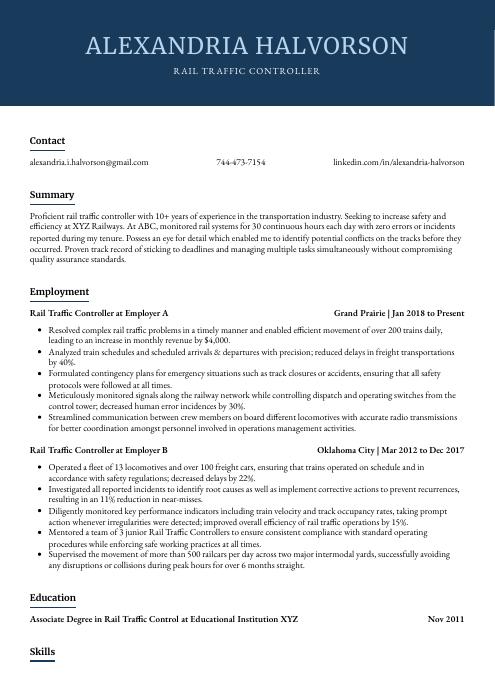 Bonobo
Bonobo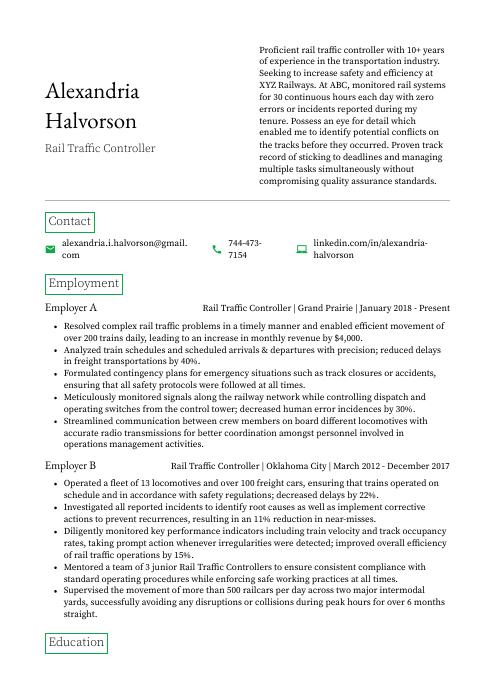 Quokka
Quokka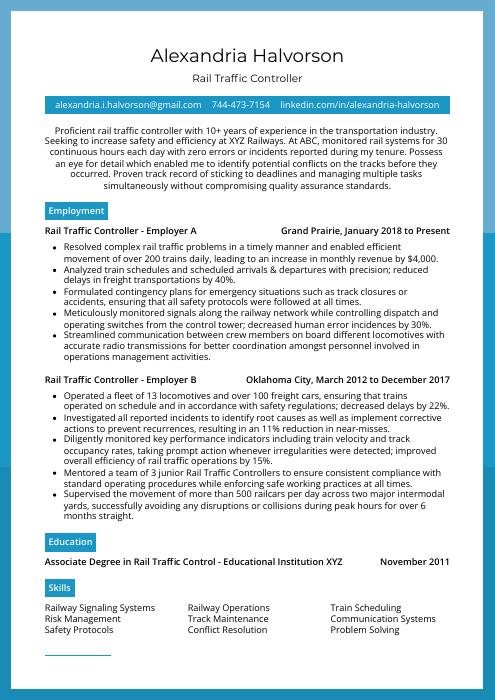 Rhea
Rhea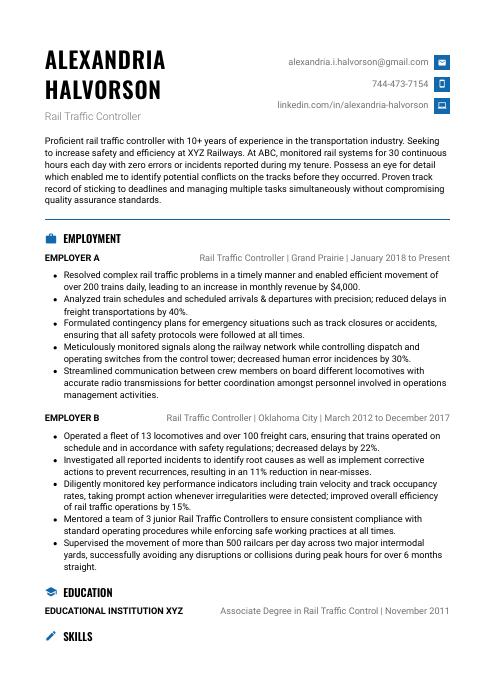 Echidna
Echidna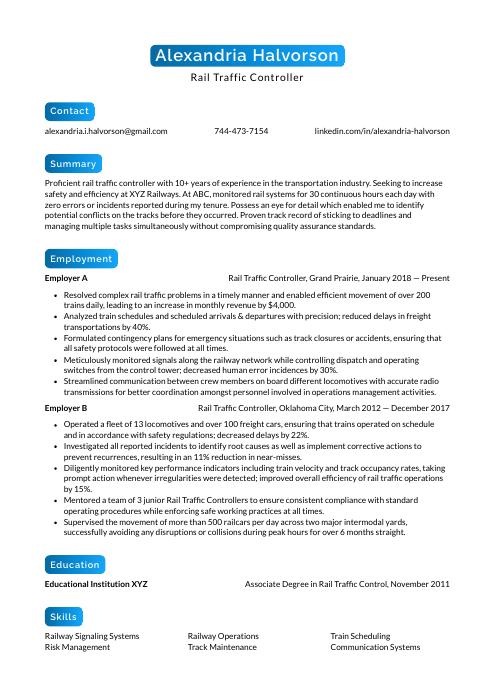 Kinkajou
Kinkajou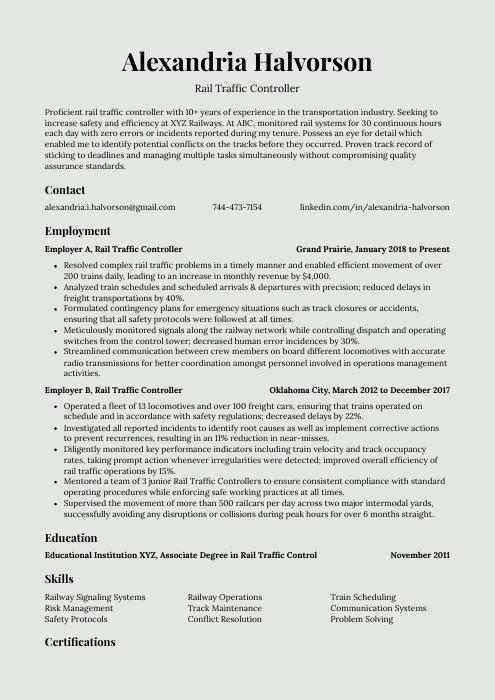 Saola
Saola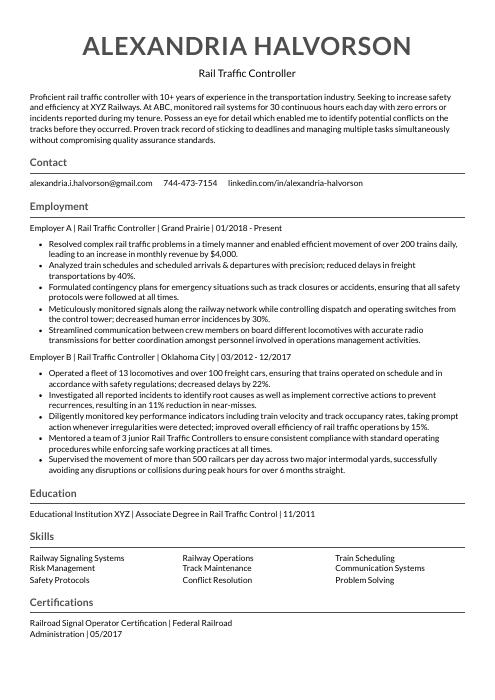 Indri
Indri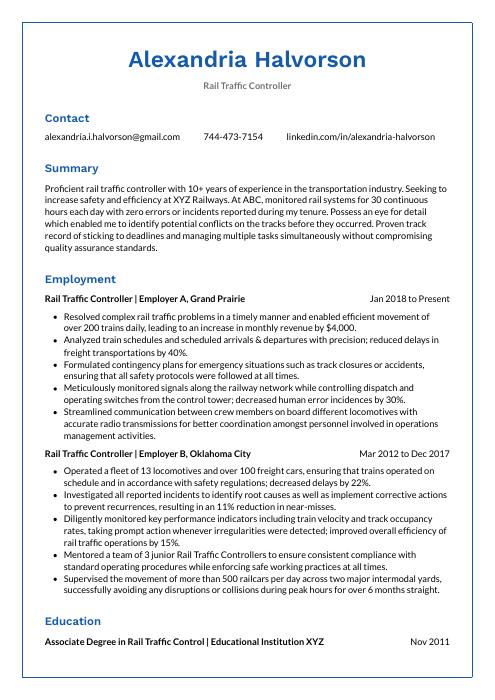 Markhor
Markhor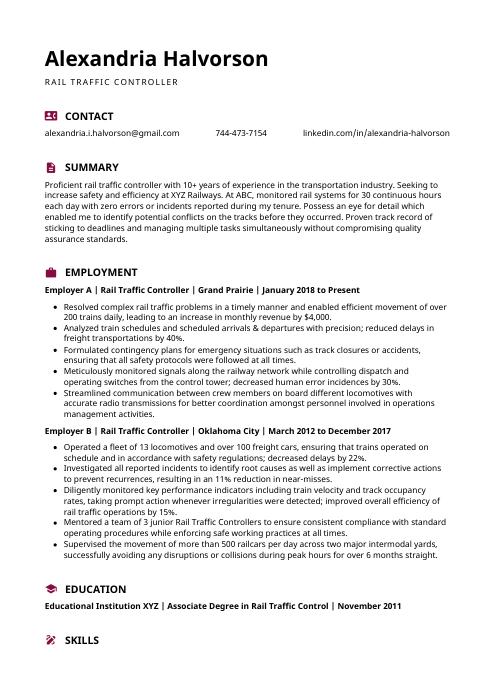 Hoopoe
Hoopoe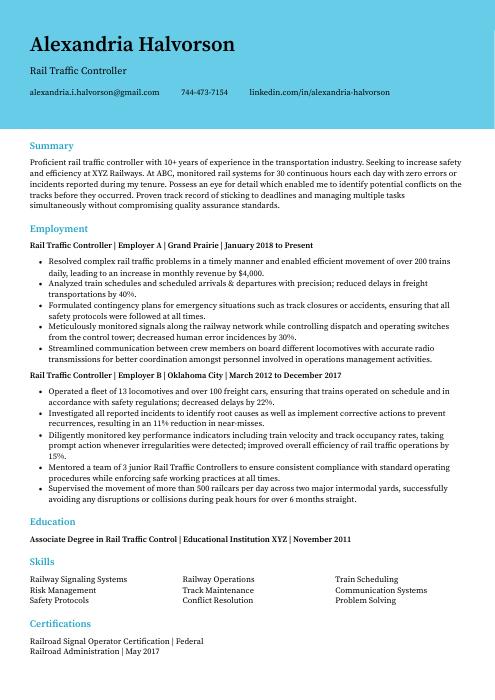 Dugong
Dugong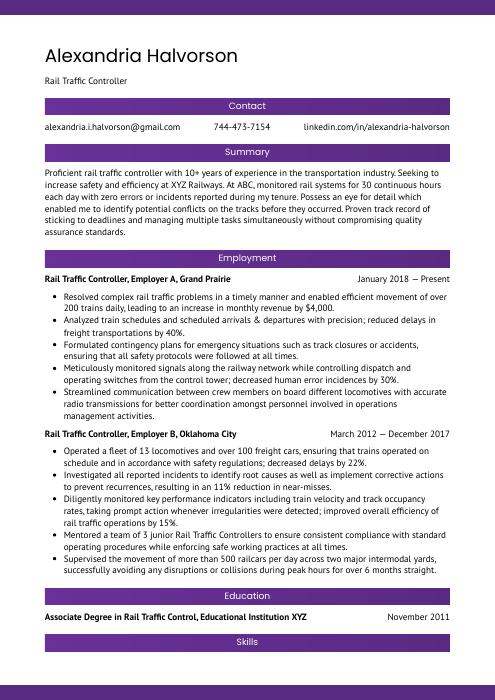 Jerboa
Jerboa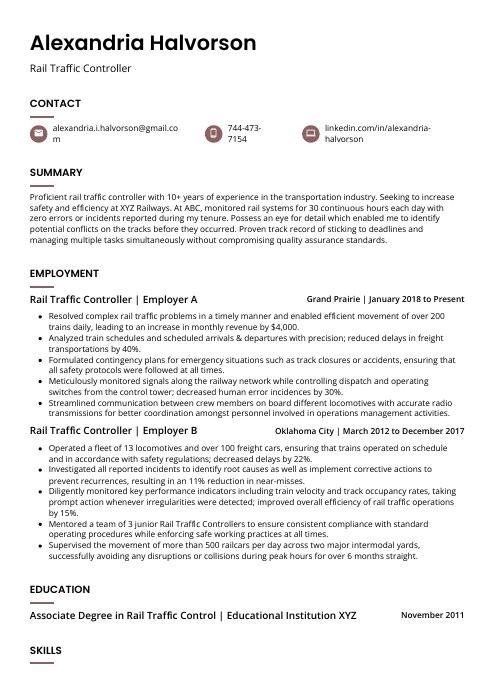 Fossa
Fossa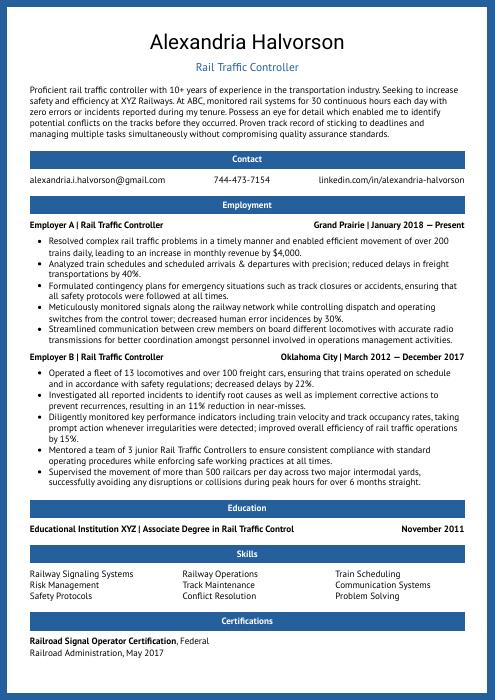 Ocelot
Ocelot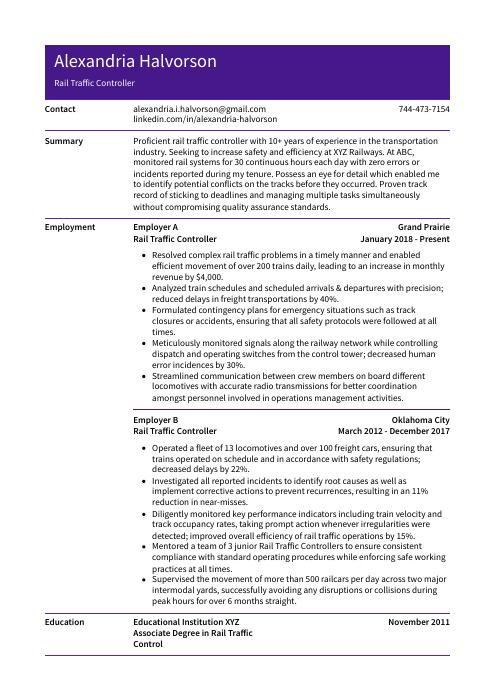 Pika
Pika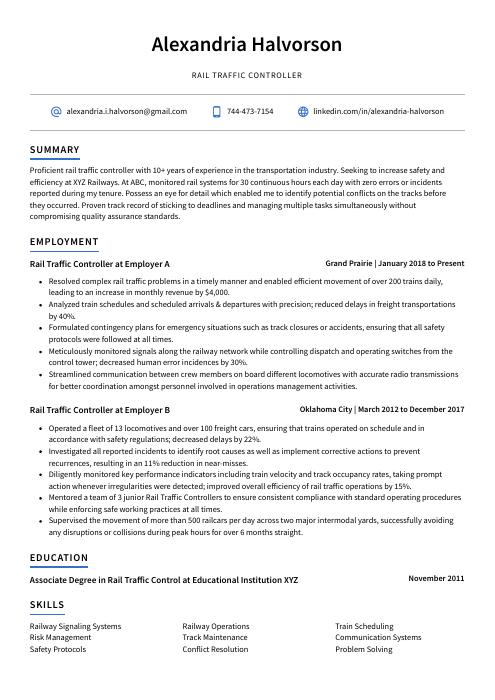 Axolotl
Axolotl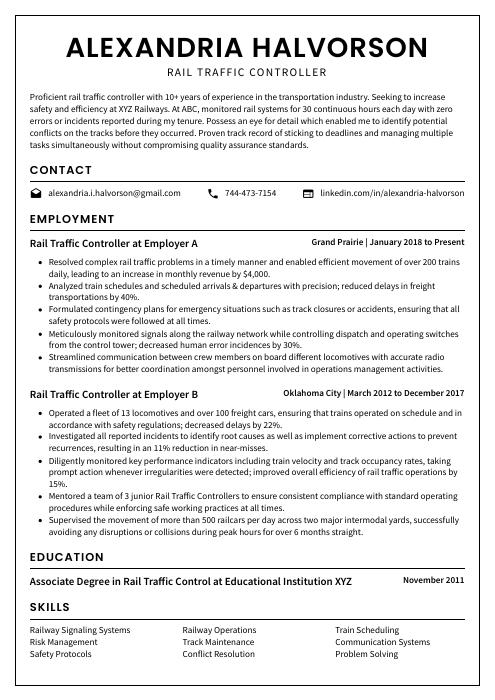 Cormorant
Cormorant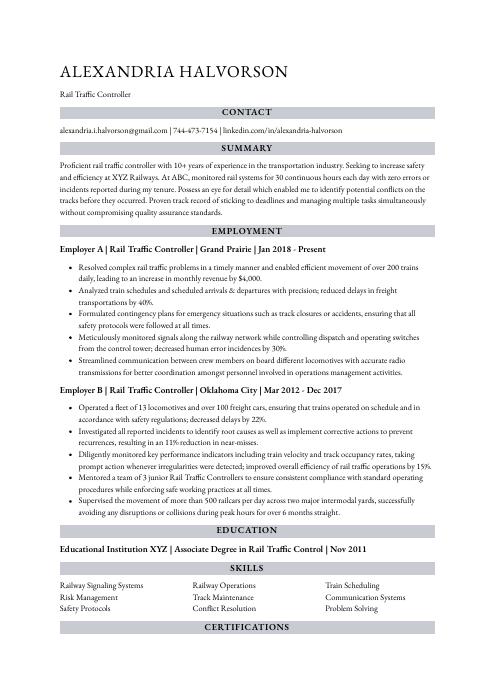 Numbat
Numbat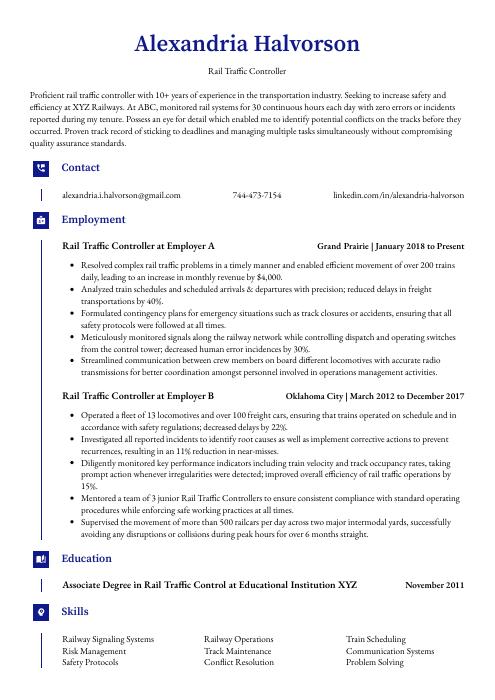 Gharial
Gharial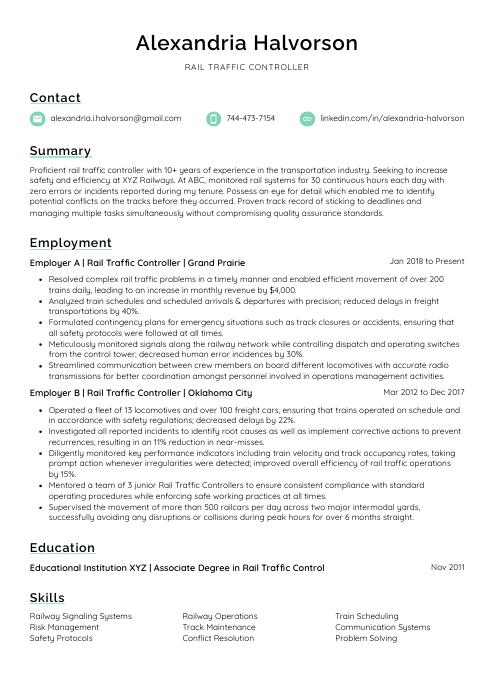 Lorikeet
Lorikeet Rezjumei
Rezjumei
